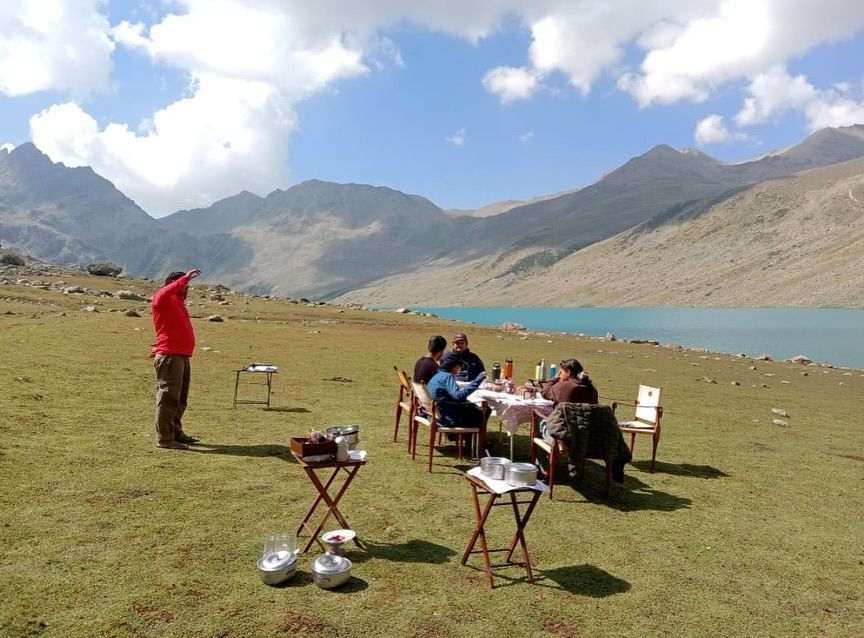Introduction
Imagine the serene beauty of a river, at dawn, the sun rising slowly over the horizon, and the excited chatter of your family as you prepare for a day of fishing. A family-friendly catch and release fishing trip offers the perfect blend of adventure, bonding, and nature appreciation.
This blog post is your comprehensive guide to planning a memorable and sustainable fishing expedition that everyone in the family will cherish. From selecting the ideal location to ensuring safety and fun, discover all you need to know to create lasting memories.
Why Choose a “Catch and Release” Fishing Trip?
Choosing a “catch and release” fishing trip is a wonderful way to engage with nature while teaching important lessons about conservation. This eco-friendly approach means enjoying the thrill of the catch without impacting fish populations. For families, it’s an opportunity to educate children about respecting wildlife and the environment. It enhances the joy of fishing, knowing that you’re leaving the ecosystem as you found it. Engaging in catch and release also often means exploring less traveled areas, offering a more serene and immersive experience.
Furthermore, this type of fishing encourages skill development. It requires technique and patience, offering a challenge that can be immensely rewarding. Families can learn together, improving their angling skills and understanding of aquatic ecosystems. Plus, with catch and release, there’s no pressure to keep the biggest or the most fish, allowing for a relaxed and enjoyable outing.
Lastly, catch and release trips are suitable for all ages and skill levels. Whether you’re a seasoned angler or a beginner, you can participate and enjoy the experience. Kids find it particularly fascinating as they get to see different fish species up close before releasing them back into their habitat. It’s an educational and exciting way to spend time together outdoors.
Selecting the Perfect Location
When planning your family fishing trip adventure, choosing the right location is crucial. Look for bodies of water known for a variety of fish species that thrive in catch and release programs. National parks, wildlife reserves, and family-friendly fishing lakes often have areas designated for catch and release. Doing some research on local regulations and available facilities can help ensure a smooth and enjoyable trip.
Consider accessibility when choosing a location. You’ll want a place that’s easy for all family members to reach, with amenities like restrooms and picnic areas. Some locations might offer additional activities such as hiking trails or playgrounds, which can be great for young children who may not want to fish all day. Also, check the best times for fishing in the area; early mornings or late afternoons are often the most fruitful.
It’s also wise to consider the weather and seasonality. Some locations are more suited to fishing during specific months when water levels and temperatures create optimal conditions for fish activity. Check weather forecasts and plan accordingly, ensuring you pack the necessary gear for comfort and safety. With the right location, your family will enjoy both the fishing and the natural beauty surrounding the area.
Preparing Your Gear
Proper preparation is key to a successful Family Fishing Trip . Begin by assembling the basic fishing gear needed for catch and release, including rods, reels, hooks, and a tackle box with essentials like bait and lures. Opt for barbless hooks as they are gentler on fish and facilitate easier releases. Make sure to bring extra lines and weights, as well as a net designed to minimize harm to the fish.
Packing the right accessories will enhance your trip. Consider portable chairs or stools for comfort, especially if the fishing spot doesn’t have seating. A cooler with snacks and drinks will keep your family hydrated and energized. Don’t forget insect repellent and sunscreen to protect against the elements. For safety, a first aid kit should be on hand to manage minor cuts or scrapes.
Teaching your family how to use the equipment is part of the fun. Before the trip, spend some time practicing casting and reeling techniques, especially with younger children. This can be done in your backyard or at a local park. Familiarity with the equipment will boost everyone’s confidence and make the actual fishing day more enjoyable.
Understanding Local Regulations
Adhering to local fishing regulations is an essential aspect of responsible fishing. Regulations vary depending on the region and body of water, so it’s important to research them beforehand. This may include obtaining fishing licenses, understanding limits on the number or size of fish, and recognizing protected fish species. Many areas require specific tackle or bait, especially in catch and release zones, to minimize harm to the fish.
Educating your family about these regulations can be a valuable learning experience. Discussing the reasons behind certain rules helps children understand the importance of conservation and respecting wildlife. It also ensures that everyone is prepared to follow the guidelines during the trip, avoiding any unintentional rule-breaking.
Local visitor centers or fish and wildlife websites are excellent resources for up-to-date information on fishing regulations. They often offer maps, brochures, and advice specific to the area. Engaging with these resources will not only ensure compliance but also enhance your understanding of the local ecosystem and the species you’re likely to encounter.
Tying Strong Knots
A crucial skill for any fishing trip is knowing how to tie strong knots. This ensures that your line stays secure when casting and reeling in fish. Practice tying essential knots like the Palomar knot, improved clinch knot, and loop knot. Each has specific uses, but all are important for securing lines and lures effectively.
Teaching knot-tying to your family can be an engaging pre-trip activity. Use thick ropes or strings at first to make it easier for children to see and mimic the steps. Once they’re comfortable, switch to the actual fishing line. Encourage everyone to practice until they can tie the knots efficiently and confidently.
Remember, having strong knots reduces the likelihood of losing fish and makes the overall experience more rewarding. It also means fewer interruptions to re-rig lines, allowing more time for actual fishing. Mastering this skill contributes to a successful catch and release trip by ensuring your gear is reliable and ready for action.
Practicing Patience
Fishing is as much about patience as it is about technique. Teaching your family to enjoy the calm and quiet of nature, rather than focusing solely on catching fish, will make the experience more fulfilling. Encourage everyone to appreciate the surroundings, the company, and the process itself.
Patience is particularly important in catch and release fishing, where the goal is not just to catch but also to carefully release the fish back into their habitat. This requires gentle handling and an understanding of the proper techniques for unhooking and releasing. Patience ensures fish are returned safely and helps avoid stress or injury.
Developing this patience also translates into life lessons. It fosters a sense of mindfulness and presence, allowing your family to enjoy the moment. Discussing the day’s experiences afterward can highlight the joys found in waiting and watching, reinforcing the value of patience in and out of the fishing environment.
Techniques for “Catch and Release”
 Executing the “catch and release” technique correctly is critical for the well-being of the fish. Start by choosing appropriate gear that minimizes injury, such as barbless hooks. When a fish is caught, handle it gently with wet hands to protect its mucus coating. If possible, use a net to support the fish while unhooking it.
Executing the “catch and release” technique correctly is critical for the well-being of the fish. Start by choosing appropriate gear that minimizes injury, such as barbless hooks. When a fish is caught, handle it gently with wet hands to protect its mucus coating. If possible, use a net to support the fish while unhooking it.
The unhooking process should be quick and efficient. Have pliers on hand to help remove the hook without causing damage. If the hook is deeply embedded, it’s often better to cut the line rather than struggle with removal, which can harm the fish. After unhooking, hold the fish in the water, gently supporting it until it swims away on its own. This process allows it to regain strength and orientation before release.
Practicing these techniques before your trip will make the actual experience smoother. Teaching your family how to properly handle fish ensures everyone is comfortable and confident in their role. The satisfaction of releasing a healthy fish back to its habitat is a rewarding aspect of the trip, reinforcing the ethics of conservation.
Creating a Safety Plan
Safety should always be a priority during any outdoor activity. Before embarking on your fishing trip, outline a safety plan that includes communication methods, first aid knowledge, and emergency procedures. Share this plan with all family members, ensuring everyone understands their role and responsibilities.
Having a reliable means of communication is crucial, especially in remote areas. Ensure that at least one family member has a fully charged phone or a walkie-talkie. Familiarize yourself with the nearest medical facilities and have a list of emergency contacts readily available.
Discuss potential hazards such as slippery banks, deep water, or encounters with wildlife. Equip your family with life vests, especially for younger children or inexperienced swimmers. Reinforce the importance of staying within sight and sound of each other. By preparing for unforeseen circumstances, you can ensure a safe and enjoyable outing for everyone involved.
Encouraging Environmental Stewardship
Instilling a sense of environmental stewardship in your family enhances the overall experience of a fishing trip. Discuss the importance of leaving no trace and maintaining the cleanliness of the fishing area. Teach your family to collect and dispose of all trash properly, including discarded fishing lines and bait containers.
Encourage mindful interactions with the environment. Observe the behavior of local wildlife from a distance, respecting their space and habitat. Share information about the ecosystem and the role each species plays in maintaining balance. These discussions can be both educational and inspiring, fostering a deeper connection with nature.
Involve your family in conservation efforts, such as planting trees or participating in local clean-up events. This active involvement reinforces the values learned during your fishing trip, creating lasting memories and a commitment to protecting our natural world for future generations.
Capturing the Moment
Documenting your family’s fishing adventure creates a lasting record of cherished memories. Bring along a camera or smartphone to capture the excitement of the catch, the beauty of the surroundings, and the smiles of your family enjoying the experience together. Encourage everyone to take turns photographing different aspects of the trip.
Consider creating a digital scrapbook or photo album to commemorate the day. Include images, captions, and even short stories or reflections from each family member. This personal touch adds depth to your collection, making it a treasured keepsake to revisit in the future.
Sharing these moments with friends and extended family can also inspire others to explore the joys of catch and release fishing. Use social media or family gatherings to showcase your adventure, sparking interest and encouraging others to venture into nature with their loved ones.
Planning for Future Trips
A successful fishing trip often leads to the desire for more adventures. Use the insights gained from your experience to plan future outings. Discuss what worked well and what could be improved, involving the whole family in the planning process. This collaborative effort builds anticipation and ensures everyone’s preferences are considered.
Research new locations and techniques to expand your family’s fishing repertoire. Explore different types of waters, from rivers to lakes to coastal areas, each offering unique challenges and rewards. Encourage your family to set goals for future trips, such as learning a new fishing technique or identifying different fish species.
By continually seeking new experiences, your family can grow together as anglers and nature enthusiasts. Each trip becomes an opportunity to strengthen bonds, expand knowledge, and deepen your appreciation for the great outdoors.
Conclusion
Planning a family-friendly catch and release fishing trip is a rewarding endeavor that fosters connection, education, and environmental awareness. By selecting the right location, preparing thoroughly, and understanding proper fishing techniques, you can create a memorable experience for your loved ones. This adventure offers the chance to bond, learn, and explore the beauty of nature together.
The significance of catch and release fishing extends beyond the trip itself, instilling values of conservation and stewardship that last a lifetime. Encourage your family to continue exploring and appreciating the natural world, embarking on more fishing adventures in the years to come. For those eager to learn more, resources and community connections await, ready to support your family’s fishing pursuits.







